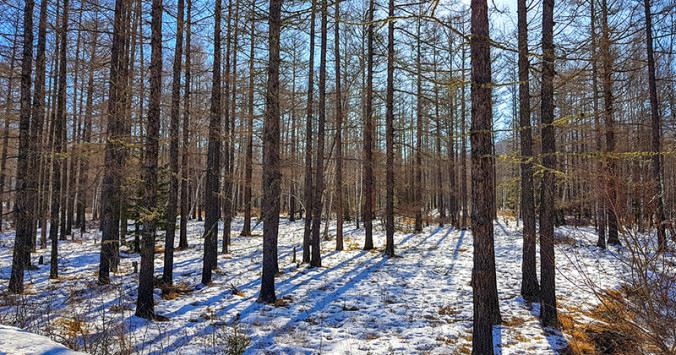The realm of the Siberian larch.
The largest forested region on the planet is the boreal coniferous tract, which accounts for about a third of the Earth’s total forest cover and dwarfs tropical rainforests. Boreal forests blanket a swathe around the Arctic Circle, across Alaska and into northern Canada. They cover about eight million square kilometres of Siberia alone, where they are known as the taiga. Vast amounts of carbon are lock up there, with so much biomass that worldwide levels of carbon dioxide and oxygen fluctuate markedly in time with northern seasons. This is the realm of the larch.
The gigantic Yenisey River flows 3200 km from Mongolia to the Arctic, dividing Siberia in two. To the west, all the way to Finland, the Siberian larch (Larix sibirica), dominates the landscape. Eastwards to Kamchatka, almost the end of the land, is the domain of its close sibling the Dahurian larch (Larix gmelinii).
The two species are very similar with only marginal differences in their habitats. However, they can be distinguished by their cones, which stand erect on the branches – soft and hairy on the Siberian larch, and with scales curved slightly outwards on the Dahurian larch.
On young larch trees the outer bark is silvery grey, becoming reddish-brown, thickened and farrowed with age.
Siberia is ridiculously inhospitable. Over the course of a year the air temperature can vary by as much as 100 degrees Celsius. In southern Siberia, these conifers grow to 30 metres or more, but near the Arctic Circle stunted by the elements, they reach just five metres.
Winter is more than freezing. In some areas the average monthly temperature for December to March is -40 degrees Celsius and nights can drop below -65 degrees Celsius.
The larches of Siberia have evolved several adaptions to handle the freezing temperatures and the related lack of liquid water. Like many high-altitude conifers, their narrow, conical profile sheds snow to prevent damage to branches. Needle-like leaves have a small surface area, reducing evaporation, and their wax coating also prevents dehydration.
Usually for conifers, larches are deciduous. In the dying days of summer, they turn a spectacular yellow-gold and drop their needles, cutting water loss even more. In autumn they adjust their anti-freeze biochemistry by increasing the amount of turpentine in their thick bark and wood, and replacing water that would freeze and rupture cells with various sugars.
Larch timber is very commonly used in the construction of buildings and for timber cladding, flooring, boat building and veneers, and as a source of pulp for paper-making. There are large Siberian larch plantations in Finland and Sweden – so much more readily accessible than in the challenging environment of Siberia.
Siberian larch floor.
